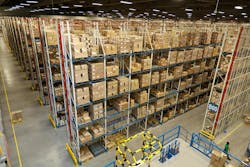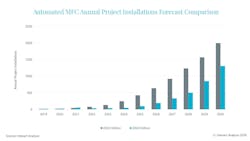Automated Micro-Fulfillment Centers Can Grow if Challenges Overcome
The market for automated micro-fulfillment centers (MFCs) has faced a series of challenges to adoption, according to a recent report from Interact Analysis.
However, opportunity in this market still remains high, and could grow to an annual revenue of $3.5 billion by 2030 if several barriers are removed.
“Overall, the automated MFC market is poised for substantial growth, driven by the increasing demand for localized fulfillment and advancements in automation technologies," said Rowan Stott, research analyst at Interact Analysis, in a statement. "As major retailers continue to invest in these solutions, the market is set to rapidly expand, offering significant opportunities for vendors and stakeholders in the industry.”
Nascent stages of growth
The deployment of automated MFCs has faced several challenges which fit into two categories: productivity inhibitors and hidden costs.
Productivity inhibitors include the integration of manually picked items, with those selected by automation proving inefficient therefore reducing overall system throughput. Advancements in manual in-store fulfillment software have also narrowed the ROI gap, diminishing the appeal of automated solutions. Additionally, macroeconomic factors, such as rising living costs, have also encouraged consumers to favor in-store shopping over delivery services, further dampening demand.
Furthermore, hidden costs like construction delays and process refinements - along with productivity inhibitors like bottlenecks in the consolidation of manually picked items and MFC replenishment - have also negatively impacted ROI, making the adoption of automated MFCs less attractive.
These barriers to adoption must first be addressed. If they aren’t, the number of MFC deployments will be lower than expected.
What does the future hold for MFCs?
Overall, the market is projected to experience significant growth, with a forecast compound annual growth rate (CAGR) of 65% from 2023 to 2030, reaching a market size exceeding $3.5 billion annually by 2030.
In 2024 alone, Interact Analysis predicts that grocers will spend $18.5 billion on store labor for online order picking. By comparison, the total warehousing sector will spend ~$180 billion on labor, meaning that grocery in-store fulfillment labor cost equates to 10% of the total warehouse labor costs.
The market is witnessing a bifurcation, with smaller sites for convenience orders and larger sites for weekly-shop orders. As a result, technologies such as mobile AS/RS, shuttle AS/RS, and ultra-high density storage systems are expected to play a significant role in fulfilling weekly-shop orders, while nano-fulfillment solutions are primarily going to be used in the fulfillment of convenience orders.
Labor is generally still being used for manual in store picking but the total addressable market for MFCs through localized fulfillment is increasing. Overall, the e-commerce market value for localized fulfillment is expected to increase from $1.9bn in 2023 to $4.4bn in 2030. This is mainly driven by the grocery segment but also other verticals such as healthcare and general merchandise due to the demand for shorter delivery times.

